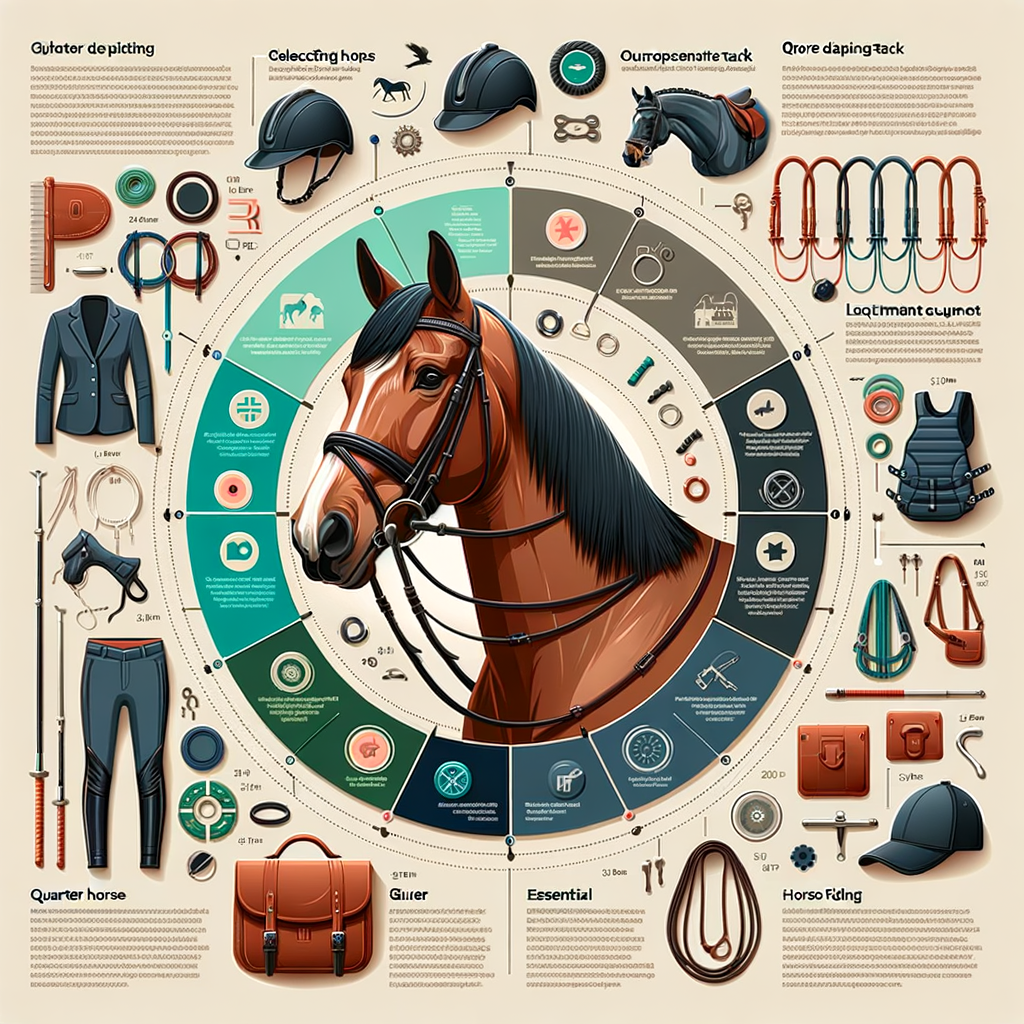
Introduction to Quarter Horse Tack
Whether you’re a seasoned rider or a novice, understanding the world of Quarter Horse tack is crucial. The right equipment can make all the difference in your horse’s performance and comfort. In this section, we will delve into the importance of proper tack selection and provide an overview of Quarter Horse equipment.
- Understanding the Importance of Proper Tack Selection
- Overview of Quarter Horse Equipment
Selecting the right tack for your Quarter Horse is not just about aesthetics; it’s about ensuring the comfort and safety of your horse. The wrong tack can cause discomfort, leading to behavioral issues and even injuries. For instance, a poorly fitted saddle can cause back pain, while the wrong bit can cause mouth injuries. Therefore, understanding the importance of proper tack selection is the first step towards a happy and healthy horse.
Quarter Horse equipment, also known as tack, includes a variety of items designed to control, communicate with, and protect the horse. Here are some essential pieces of tack you’ll need for your Quarter Horse:
| Equipment | Description |
|---|---|
| Saddle | A supportive structure for a rider or other load, fastened to the horse’s back by a girth. |
| Bridle | A piece of equipment used to direct a horse, includes a bit and reins. |
| Bit | A device placed in a horse’s mouth, used to aid in communication and control. |
| Stirrups | A pair of devices attached to either side of a horse’s saddle, in which the rider’s feet rest. |
Remember, each piece of equipment should be carefully selected and properly fitted to ensure your horse’s comfort and safety.
Comprehensive Quarter Horse Tack Selection Guide
When it comes to horse riding, the right gear is crucial. This guide will provide you with the essential information you need to select the best tack for your Quarter Horse.
Essential Horse Riding Gear
Let’s delve into the key pieces of equipment every Quarter Horse rider should have in their tack room.
- Choosing the right saddle for Quarter Horses
- Selection of bridles and bits
- Importance of proper girths and stirrups
Choosing the right saddle is paramount for both the comfort of the rider and the horse. Quarter Horses, known for their muscular build and compact body, require a saddle that fits their unique physique. A saddle that is too tight can cause discomfort and potential injury to the horse, while a saddle that is too loose can lead to instability for the rider. Therefore, it’s essential to measure your horse accurately before purchasing a saddle.
The bridle and bit are vital components of horse riding gear. The bridle is the piece of equipment that goes over the horse’s head and holds the bit, which goes in the horse’s mouth. The bit is used to control the horse’s speed and direction. When selecting a bridle and bit, consider your horse’s mouth size and shape, as well as your riding style.
Girths and stirrups are also essential pieces of horse riding gear. The girth secures the saddle to the horse, while the stirrups provide support for the rider’s feet. Both should be the correct size for your horse and comfortable for the rider. A girth that is too tight can cause discomfort for the horse, while stirrups that are too large can lead to a lack of control for the rider.
In conclusion, selecting the right tack for your Quarter Horse involves careful consideration of both the horse’s comfort and the rider’s safety. By choosing the correct saddle, bridle, bit, girth, and stirrups, you can ensure a pleasant and safe riding experience for both you and your horse.
Additional Quarter Horse Equipment
Aside from the essential riding gear, there are other equipment pieces that are specifically designed for Quarter Horses. These additional tools are crucial in ensuring the horse’s comfort and safety. Let’s delve into these items:
- Quarter Horse Specific Grooming Tools
- Protective Gear for Quarter Horses
Proper grooming is essential for the health and well-being of your Quarter Horse. It helps keep their coat shiny, promotes healthy skin, and allows you to check for any signs of injuries or illness. Quarter Horses, known for their muscular build and compact body, require specific grooming tools. These include a curry comb for loosening dirt, a body brush for removing the dirt, a mane and tail brush for detangling, and a hoof pick for cleaning their hooves. Remember, a well-groomed horse is a happy horse!
Protective gear is another crucial aspect of Quarter Horse equipment. These items help safeguard your horse from potential injuries during riding or training sessions. Some of the key protective gear for Quarter Horses include horse boots, which protect the horse’s legs from injury, and a fly mask, which shields the horse’s eyes and ears from irritating insects. Additionally, a saddle pad can provide extra cushioning between the saddle and the horse’s back, preventing sores and discomfort.
In conclusion, investing in Quarter Horse specific grooming tools and protective gear can significantly enhance your horse’s comfort and safety. Remember, a well-cared-for horse is more likely to perform better and live a healthier, happier life.
Equestrian Tack Selection: Key Considerations
When it comes to selecting the right tack for your Quarter Horse, there are several key considerations to keep in mind. It’s not just about choosing the most expensive or the most popular option. Instead, it’s about understanding your horse’s specific needs and making an informed decision based on those needs.
Understanding Your Quarter Horse’s Needs
Every Quarter Horse is unique, and so are their needs when it comes to tack. There are two main factors to consider when assessing your horse’s needs: their size and shape, and their discipline and workload.
- Assessing your Quarter Horse’s size and shape: The size and shape of your horse can greatly influence the type of tack you choose. For instance, a larger horse may require a larger saddle, while a horse with a narrow chest may need a different girth style. It’s important to take accurate measurements of your horse to ensure a proper fit.
- Considering your Quarter Horse’s discipline and workload: The type of work your horse does can also affect the tack you choose. For example, a horse used for trail riding may require different tack than a horse used for barrel racing. Consider the demands of your horse’s discipline and choose tack that will support them in their work.
By taking the time to understand your Quarter Horse’s needs, you can make a more informed decision when it comes to selecting tack. Remember, the right tack can not only enhance your horse’s performance but also their comfort and wellbeing.
Quality and Fit of Horse Tack Essentials
When it comes to equestrian tack, two key aspects to consider are the quality of the materials used and the fit of the equipment on your Quarter Horse. Let’s delve into these two crucial topics.
- Identifying High-Quality Materials in Tack
- Leather: Look for tack made from full-grain leather. This type of leather is durable and can withstand the rigors of riding. It should feel supple and smooth to the touch.
- Metal: Check the buckles and other metal parts. They should be made from stainless steel or brass for durability and resistance to rust.
- Stitching: The stitching should be tight and even, with no loose threads. This indicates good craftsmanship.
- Ensuring Proper Fit of Quarter Horse Riding Equipment
- Saddle: The saddle should sit level on your horse’s back. There should be enough clearance between the saddle and the horse’s spine.
- Bridle: The bridle should fit snugly, but not too tight. You should be able to slip two fingers between the bridle and your horse’s head.
- Girth: The girth should be tight enough to keep the saddle in place, but not so tight that it restricts your horse’s breathing.
High-quality materials are essential in ensuring the longevity and effectiveness of your horse tack. They also contribute to the comfort and safety of your horse. Here are some pointers to help you identify high-quality materials:
A well-fitted tack is crucial for the comfort and safety of your Quarter Horse. Here are some tips to ensure a proper fit:
Remember, the key to a successful tack selection lies in balancing quality and fit. Both are equally important in ensuring your Quarter Horse’s comfort, safety, and performance.
Case Studies: Successful Tack Selection for Quarter Horses
Let’s delve into some real-life examples of successful tack selection for Quarter Horses. These case studies will provide practical insights into the process and help you make informed decisions for your own horse.
-
Case Study 1: Choosing tack for a beginner’s Quarter Horse
Meet Daisy, a 5-year-old Quarter Horse owned by a beginner rider, Sarah. As a novice, Sarah was unsure about the right tack for Daisy. She started with a basic saddle and bridle, prioritizing comfort and safety. Over time, as Sarah’s skills improved, she added more specialized gear, like a snaffle bit and a western saddle, perfect for Daisy’s low, smooth gaits.
Key takeaway: Start simple and prioritize comfort and safety. As your skills improve, you can add more specialized gear.
-
Case Study 2: Selecting gear for a competitive Quarter Horse
Next, we have Thunder, a competitive Quarter Horse owned by professional rider, Mark. Thunder participates in various events, including barrel racing and roping. Mark selected a lightweight, durable saddle to allow for quick movements. He also chose a curb bit for better control during high-speed events. Thunder’s tack is regularly inspected and replaced as necessary to ensure peak performance.
Key takeaway: Choose gear that suits your horse’s activities. Regular maintenance is crucial for safety and performance.
In conclusion, the right tack for your Quarter Horse depends on your skill level and your horse’s activities. Whether you’re a beginner or a professional, comfort, safety, and suitability should always be your guiding principles in tack selection.
Quick Reference Table
| Case Study | Owner’s Experience Level | Horse’s Activity | Key Tack Pieces | Key Takeaway |
|---|---|---|---|---|
| 1: Daisy | Beginner | General Riding | Basic Saddle, Bridle, Snaffle Bit, Western Saddle | Start simple, prioritize comfort and safety. Add specialized gear as skills improve. |
| 2: Thunder | Professional | Competitive Events | Lightweight Saddle, Curb Bit | Choose gear that suits horse’s activities. Regular maintenance is crucial. |
Conclusion: Your Quarter Horse Owners Guide to Tack Selection
As we wrap up our comprehensive guide on tack selection for Quarter Horses, it’s essential to revisit the key points we’ve discussed. This will ensure that you, as a Quarter Horse owner, are well-equipped to make informed decisions about your horse’s tack.
- Recap of horse tack essentials
Remember, the primary pieces of tack you’ll need for your Quarter Horse include a saddle, bridle, bit, and reins. However, the choices don’t stop there. You’ll also need to consider the material, fit, and comfort of each piece of tack. For instance, leather is a popular choice for its durability and comfort, but synthetic materials can also be a good option for their easy maintenance and affordability.
When it comes to fit, it’s crucial to ensure that your horse’s tack fits perfectly. An ill-fitting saddle or bridle can cause discomfort and even injuries. Therefore, always measure your horse accurately before purchasing any tack.
Lastly, don’t forget about your horse’s comfort. A comfortable horse is a happy horse, and a happy horse performs better. So, always prioritize your horse’s comfort when selecting tack.
- Final thoughts on choosing tack for Quarter Horses
Choosing the right tack for your Quarter Horse is not just about buying the most expensive items on the market. It’s about understanding your horse’s needs and preferences, and selecting tack that meets those needs.
Remember, every horse is unique. What works for one Quarter Horse may not work for another. Therefore, always take the time to understand your horse’s unique characteristics and needs before making a decision.
Lastly, always prioritize quality over quantity. A high-quality piece of tack may cost more upfront, but it will last longer and provide better comfort and performance for your horse. So, don’t be afraid to invest in quality tack for your Quarter Horse.
In conclusion, selecting the right tack for your Quarter Horse is a process that requires careful consideration and understanding of your horse’s needs. But with the right knowledge and approach, you can ensure that your horse is comfortable, happy, and ready to perform at their best.









